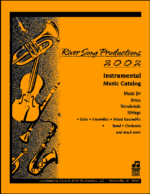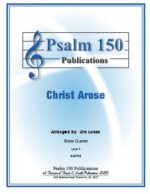-
Here Is Love (Bb/C/BC solo)
$29.95“Here Is Love” was originally penned by the Welsh poet William Rees (1802-1883) then translated from Welsh into English by William Edwards (1848-1929). The text is based on one of the most famous Scripture references, John 3:16 “For God so loved the world that he gave his one and only Son, that whoever believes in him shall not perish but have eternal life” (NIV). The beautiful melody that accompanies the text was composed by American gospel songwriter Robert Lowry in 1876. Although this hymn is 150 years old, it remains popular today.
-
Christ Arose
$4.50This French horn solo opens with a sense of an early morning awakening and then breaks into a gently modified rendition of the tune. The second section becomes more spirited with a sense of expectation and then settles back down into the mood of the opening, only to become enlivened again. The final section recaps the material from earlier sections and then ends with a statement of victory!
-
Follow On
$9.00A flute quartet, with optional 4th part for clarinet, this cheerful rendition just bubbles all over the place. A piccolo solo can be incorporated in an Alla Sousa fashion if desired.
-
Christ Arose
$9.00A brass trio for trumpet, horn, trombone, and piano with optional parts for trumpet and baritone, this colorful arrangement modifies the melody with various rhythmic devices with many cascading effects.
-
We’re Marching To Zion
$11.00A traditional woodwind quintet with opt. Alto sax and bass clarinet parts. The pieces is constantly effervescent with delightful embellishing devices. The ending section is slower and expressive exhibiting a sense of confidence.
-
-
-
-
-
-
-
-
-
-
Nothing But the Blood
$32.00Beginning with a fanfare motif (in Eb) the theme alternates between dynamic shifts as though a question and answer. The lower instruments then augment the melody, followed by imitation in the upper voices. The ending mirrors the fanfare of the beginning.
-
Christ Arose
$12.00Scored for traditional brass quintet, an optional bartione part can be used to expand the piece to a sextet. After an opening upper brass fanfare, the lower parts present the theme in solemn fashion with further extended fanfares from the upper lines. The middle section reverses the stylistic assignments only to be given back to the opening styles. The with a powerful stacking of parts the piece concludes in a triumphant chord.















